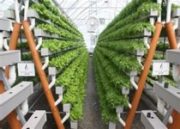The agricultural industry is entering an increasingly rapid pace of change. It was only yesterday (and today) that farmers were encouraged to use no-plow techniques for large crop fields. Basically, the intent is to let indigenous plants provide a cover crop so that (a) good soil will not continue to blow away or wash away (b) the indigenous plants will provide better chemistry and require less commercial plant food in the soil and (c) the indigenous plants would retain CO2 in the soil. Changing farming practices is very difficult for farmers.
There are other practices that are changing. A small number of commercially large farms have decided to pursue zero fossil fuel in their operation. Manure, crop waste solar power and chemical conversions are used to produce electricity, feed and fertilizer.
These and other similar efficiency-based crop practices are an excellent effort but the circumstances surrounding a human population approaching 8 billion by 2030 and little land left to increase agricultural production has taken farming in a different direction.
Everyone has heard of hydroponic gardening (grown in water without soil) but aggressive corporations are taking hydroponics to extreme levels. Soil and vast acreages have a small role to play in large quantity production. Combined with the use of solar and wind energy, these farms have no season – they are year-round.



Add to the plant operation the quandary of what to do about cows. Long a joke, it is a fact that through flatulence and digestion, cows produce 40 percent of atmospheric methane. Cows generate methane in two main ways: through their digestion and through their waste. Cows are part of a group of animals called ruminants. Ruminants have stomachs with four distinct chambers. Sheep, goats, and giraffes also are ruminants. Even on television there are ads suggesting that everyone fight climate change by not eating beef.
The other side of cow economics is provided by Mother Nature. She is causing drought and water shortage in the primary wheat-growing regions of the southwest. Cows et al eat wheat – and a lot of water!
There are critics who say “Why eat the cow? Eat the grass the cow would eat.” As mariner mentioned in an earlier post: Perhaps anchovies, scrapple and spam may become popular again.
Ancient Mariner
